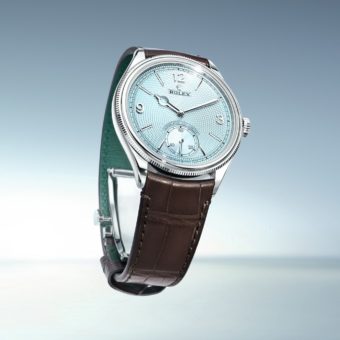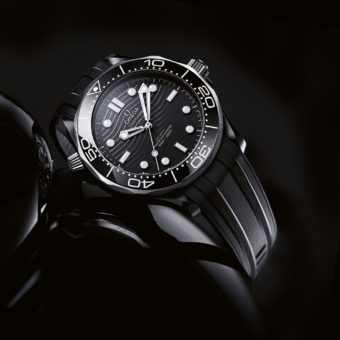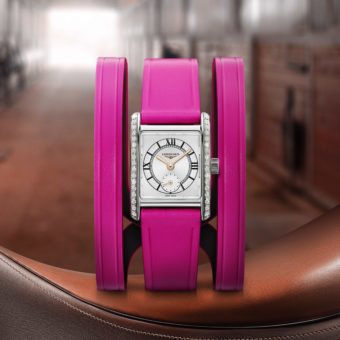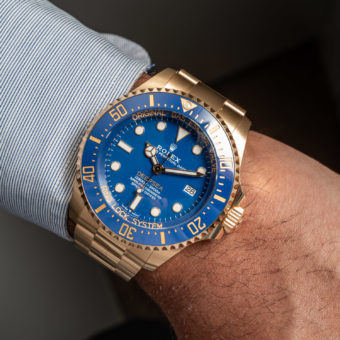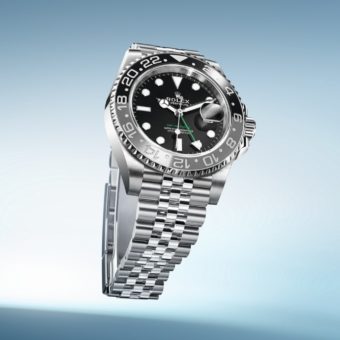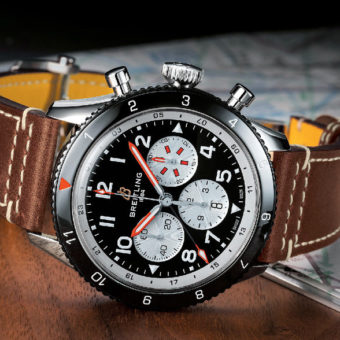This article was originally published in the November/December 2022 Issue of the WatchTime print magazine.
The heart of the Longines Ultra-Chron beats 10 times per second. Both the high-frequency automatic Caliber L836.6 and the design of this dive watch are inspired by the original Longines Ultra-Chron Diver from 1968, which was the first dive watch with a high-frequency movement. Our test shows that this Swiss brand is as competent in the field of sports watches as it is in high-speed oscillators.
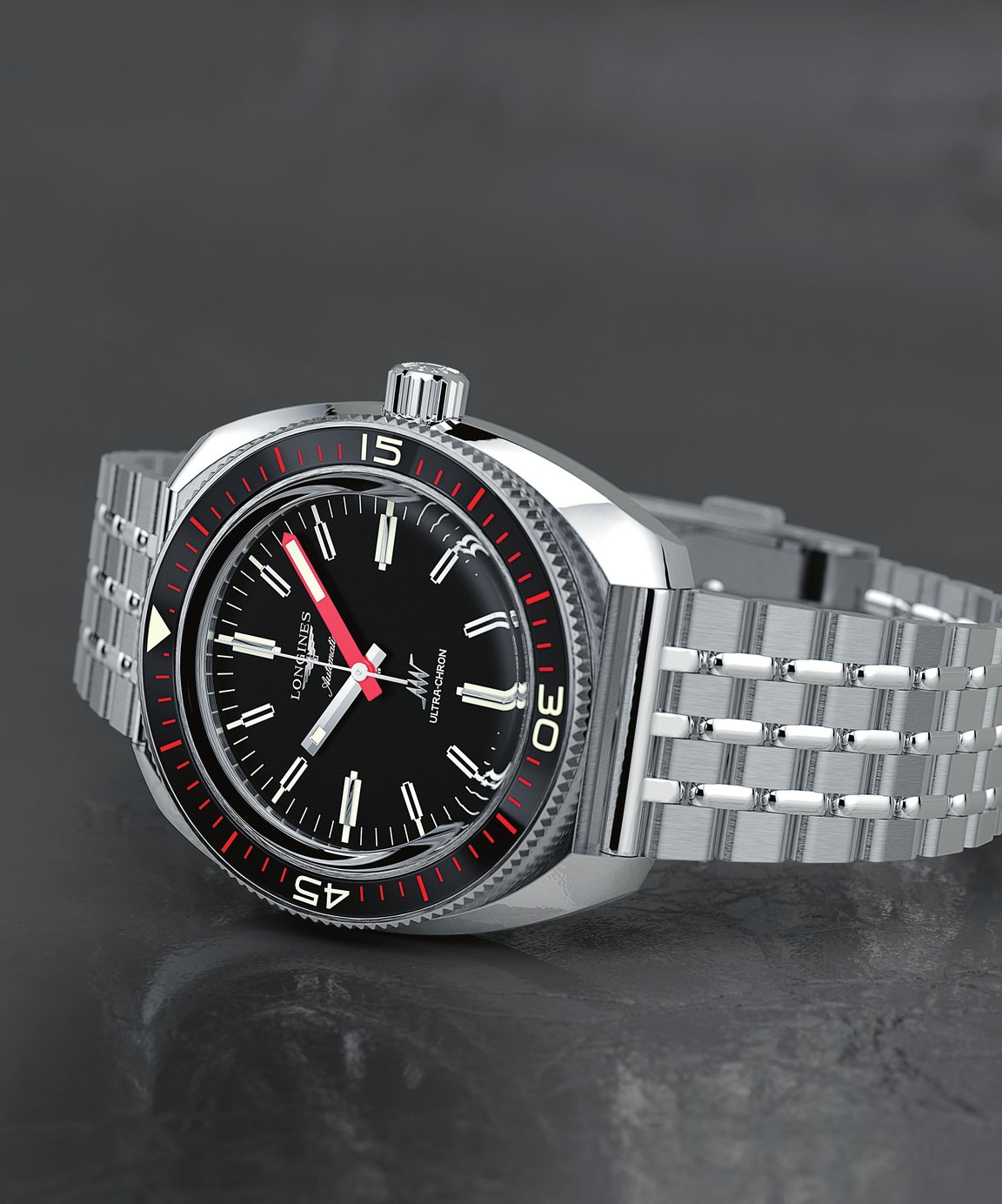
Apart from the legendary El Primero from Zenith and a few movements from Grand Seiko, there are hardly any serially manufactured calibers with balances that oscillate at a frequency of 5 Hz, which is equivalent to 36,000 vibrations per hour. There have been a small number of talking pieces, such as those from Audemars Piguet, Breguet, Chopard and TAG Heuer, that oscillate at a somewhat speedier pace, but not with consistency and not at affordable prices. That’s why the astonishment sparked in us by the Longines Ultra-Chron was followed by an “aha” moment. The brand with the winged hourglass logo can proudly recall its pioneering spirit in the development of watch movements. Longines turned its attention to high-frequency oscillators quite a long time ago.
As early as 1914, Longines created the first high-frequency instrument capable of measuring time to the nearest 1/10th of a second. In 1959, the brand developed the first high-frequency movement for a wristwatch. This observatory chronometer set new precision records. In October 1966, Longines registered the name “Ultra-Chron” for a timepiece that was more accurate than a COSC-certified chronometer. And in 1968, the Ultra-Chron Diver was introduced as the first dive watch to encase a high-frequency movement, Caliber 431.
By 1968, if not before, Longines had firmly established itself as a pioneer of high-frequency technology. But in the course of the far-reaching changes in the watch industry brought about by the emergence of quartz technology, Longines completely stopped manufacturing its own calibers in 1986. Three years earlier, in 1983, Longines had been acquired by SMH (Société de Microélectronique et d’Horlogerie), which later became the Swatch Group.

Longines’s acquisition by the Swatch Group was not necessarily a disadvantage for the development of the brand’s movements. Various developmental competencies, ranging from fine mechanics and electronics to modern silicon technology, are under the umbrella of movement specialist ETA, which also belongs to the Swatch Group. ETA’s movements are available to various brands that are part of the Swatch Group, but they also serve as the basis for movements that are made exclusively for an individual brand. For example, Longines played a key role in the development of the exclusive L688.2 chronograph column-wheel caliber, which is based on the ETA A08.231 that had been available to the brand since 2009. Another example are the movements for the brand’s recently introduced Spirit collection and especially for the Spirit Zulu Time with GMT function. And last but not least, Longines participated in the development of the new automatic Caliber L836.6, which is a special version of ETA’s self-winding Caliber C07.811.
The brand states, “With centuries of watchmaking expertise, Longines has pioneered numerous technical developments and even today continues to cultivate an unstoppable spirit of innovation. The constant striving for excellence has led Longines to equip all of its automatic timepieces with state-of-the-art movements that have silicon hairsprings.” Silicon hairsprings are one of Longines’s unique selling points.
Silicon is not only particularly lightweight and corrosion resistant, it is also resistant to temperature fluctuations and magnetic fields. The material’s physical properties improve the accuracy and longevity of the Ultra-Chron and enable Longines to give a five-year guarantee on this timepiece, which is specially tested before it leaves the factory. The Ultra-Chron has earned its chronometer certificate from Timelab, an independent Geneva-based laboratory that also certifies watches made by other manufacturers. Timelab’s certification goes beyond the usual chronometer tests, which scrutinize a timepiece’s water tightness, resistance to magnetism, power reserve and performance on the wrist. The entire watch, not just its movement, is subjected to a 15-day rate test and a series of other tests at three temperatures (8, 23 and 38 degrees Celsius) according to the strict criteria of ISO/IEC 3159:2009.

A balance with a high frequency of 36,000 vibrations per hour demands much more power from the mainspring than is required by a slower oscillator. Longines discovered this fact when it developed observatory chronometers in the 1960s. One consequence of the high demand for power is that Caliber L836.6 can offer only a 52-hour power reserve. This interval is still acceptable, but undeniably shorter than the 80 hours of power provided by ETA’s Caliber C07.811, which is paced at a frequency of 3 Hz and on which the L836.6 is based. The use of a silicon hairspring, which Longines stipulates for its top automatic calibers, compensates for part of the power loss caused by the higher frequency.
Longines’s experience with high-frequency calibers has also shown that faster oscillators offer greater consistency between vertical and horizontal positions, and that the amplitude declines less steeply over the course of a day, which further contributes to their accuracy. Our rate tests on an electronic timing machine confirmed this. The differences among the individual positions were extremely small: they ranged between 1.8 and 2.8 seconds. The rate values were likewise excellent, deviating by less than 1 second per day when the watch was fully wound and when being worn. The amplitude fluctuations, on the other hand, remained within the usual range over the course of 24 hours. The rate performance was nonetheless extremely impressive, so the Ultra-Chron has every right to its chronometer certificate.

Caliber L836.6 is a special movement and is housed inside an equally special case with a retro cushion shape measuring 40.8 by 41.9 mm. With polished bevels toward the satinfinished flanks, this new model closely resembles the original Ultra-Chron from 1968, but its case looks slightly more elongated because a divers’ bezel covers its entire middle section. The bezel can only be rotated counterclockwise and clicks into place relatively unspectacularly at half-minute intervals, but the sapphire crystal that covers the rotating ring lends handsome three-dimensionality and a touch of extravagance to the bezel, which gains a professional touch from its full circle of red minute strokes. Longer strokes emphasize the 5-minute marks and luminous Arabic numerals are at three of the quarter hours, completed by a luminous triangle at the 12. This practical arrangement shows the longstanding expertise of the brand.
The Ultra-Chron was already water resistant to 200 meters in 1968. Its current edition can resist pressure up to 30 bar. The distinctively styled hour indexes atop the grained, matte black dial are nearly identical to the historical predecessor. The four shiny main indexes at the quarter hours are faceted, applied and flanked by luminous bars. When the bezel is set to its basic position, these indexes are next to luminous numerals at three of the quarter hours and to the orientation triangle at the 12.

Atop the asphalt-like background of the dial, eight smaller indexes are cleanly printed in the form of long white double lines connected by slender crosswise lines. These are not luminous, but each pair of double lines has a luminous stroke next to it at 5-minute intervals in the circle of white indexes around the edge of the dial. The overall result provides excellent legibility in all lighting conditions, including in the murky depths under water. The functionality is further enhanced by the minute hand, which is important for diving and bears a much longer luminous bar than the hour hand. The minute hand’s red color together with the red scale around the bezel combine to support the watch’s usefulness for diving. The sapphire crystal above the dial is antireflectively treated several times and assures that all displays are easy to read. The steep curvature around the crystal’s rim accentuates the retro character of this model. The only drawback with regard to the diving function is that the second hand lacks the luminous tip that was present on the original model, where its motion showed that the watch was still running.
Our test watch has an elegant, high-quality, seven-row, stainless-steel bracelet whose components are alternately polished and satin-finished. The bracelet is secured by a folding clasp, which is hinged on one side and includes a mechanism that allows you to add or subtract a maximum of 8 mm in the length in four 2-mm steps. This is not a divers’ extension for wearing the watch over the sleeve of a wetsuit, but only a fine-adjustment option. If you wish, the bracelet can be shortened by asking a watchmaker to unscrew the bars near the clasp. An additional strap made of recycled textile is provided for diving. This second wristband is delivered with the watch in a presentation box along with a special strap-changing tool. You might want a modern quickchange system, which would be relatively easy to integrate at the lugs. But even without this convenience, the Ultra-Chron is a unique and popularly priced timepiece that admirably combines the professionalism of a sporty dive watch with a distinctive historical identity and the pulsating power of a modern high-frequency caliber.
To learn more about Longines, click here, and to subscribe to the WatchTime print magazine, click here.

